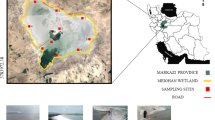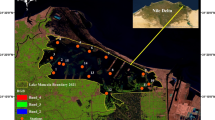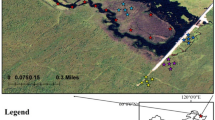Abstract
Eutrophication is a major problem in the international Anzali wetland (northern Iran). The present research initially aimed to determine the trophic state index (TSI) in ten sampling sites in the main parts of the Anzali wetland (western, eastern, central, and Siahkeshim parts). After determining the TSI in the wetland, a data-driven method (classification tree model with a J48 algorithm) was implemented to predict the trophic condition in the wetland based on a set of water quality and physical-structural variables. One hundred twenty samples related to chlorophyll-a (the model’s output) and environmental variables (the model’s inputs) were measured monthly during 1-year study period (2017–2018). Based on the TSI calculation, the western, Siahkeshim, eastern, and central parts of the wetland are classified as eutrophic, super-eutrophic, hyper-eutrophic, and hyper-eutrophic, respectively. When all environmental variables were introduced to the model (with five-time randomization effort, pruning confidence factor = 0.01, and seven-fold cross-validation), eight variables (bicarbonate, pH, water temperature, electric conductivity, dissolved oxygen, total phosphorus, water depth, and water turbidity) were predicted by the model. The model predicted that an increase in total phosphate, water turbidity, and electric conductivity concentration may contribute to the hyper-eutrophic state of the wetland. In contrast, the hyper-eutrophic of the wetland is associated with a decrease in water depth, dissolved oxygen, and pH concentration. According to ANOVA test, the trophic condition in the wetland can be affected by spatial and temporal patterns. Anthropogenic pressures such as the influx of chemicals particularly the nutrients (phosphorus and nitrogen) are the main cause of water enrichment (eutrophication problem) in main parts of the Anzali wetland ecosystem.




Similar content being viewed by others
Data availability
If article and information are requested, the corresponding author will be available to respond the request.
References
Abedini, A. (2015). The study of trophic index in Anzali lagoon. Agricultural Research and Education Organization, Iranian Fisheries Science Research Institute. Inland water aquaculture research centre, Tehran, 57 p (In Persian).
Ambelu, A., Lock, K., & Goethals, P. L. M. (2010). Comparison of modelling techniques to predict macroinvertebrate community composition in rivers of Ethiopia. Ecological Informatics, 5, 147–152.
APHA, Awwa, WEF. (2012). Standard methods for the examination of water and wastewater (22nd ed.). American Public Health Association.
Armengol, X., & Miracle, M. R. (1999). Zooplankton communities in doline lakes and pools, in relation to some bathymetric parameters and physical and chemical variables. Journal of Plankton Research, 21(12), 2245–2261.
Bekteshi, A., & Cupi, A. (2014). Use of trophic state index (Carlson, 1977) for assessment of trophic status of the Shkodra lake. Journal of Environmental Protection and Ecology, 15, 359–365.
Bennett, E. M., Carpenter, S. R., & Caraco, N. F. (2001). Human impact on erodable phosphorus and eutrophication: A global perspective: Increasing accumulation of phosphorus in soil threatens rivers, lakes, and coastal oceans with eutrophication. AIBS Bulletin., 51(3), 227–234.
Beusen, A. H., Bouwman, A. F., Van Beek, L. P., Mogollón, J. M. & Middelburg, J. J. (2016). Global riverine N and P transport to ocean increased during the 20th century despite increased retention along the aquatic continuum. Biogeosciences, 13(8):2441
Bordalo, A., Nilsumranchit, W., & Chalermwat, K. (2001). Water quality and uses of the Bangpakong River (Eastern Thailand). Water Research., 35, 3635–3642.
Breiman, L., Friedman, J. H., Olshen, R. A., & Stone, C. J. (1984). Classification and regression trees. Wadsworth.
Carlson, R. E. (1977). A trophic state index for lakes. Limnology and Oceanography., 22, 361–369.
Cloern, J. E. (2001). Our evolving conceptual model of the coastal eutrophication problem. Marine Ecology Progress Series., 210, 223–253.
Cohen, J. (1960). A coefficient of agreement for nominal scale. Educational and Psychological Measurement, 20, 37–46.
De’ath, G., & Fabricius, K. E. (2000). Classification and regression trees: A powerful yet simple technique for ecological data analysis. Ecology, 81, 3178–3192.
de Jonge, V. N., Elliott, M., & Orive, E. (2002). Causes, historical development, effects and future challenges of a common environmental problem: Eutrophication. Hydrobiologia, 475(1), 1–19.
D’heygere, T., Goethals, P.L.M. & De Pauw, N. (2003). Use of genetic algorithms to select input variables in decision tree models for the prediction of benthic macroinvertebrates. Ecological Modelling, 160, 291–300.
Deyab, M., El-Adl, M., Ward, F., & Omar, E. (2021). Trophic status, phytoplankton diversity, and water quality at Kafr El-Shinawy drinking-water treatment plant, Damietta. Journal of Water Supply: Research and Technology-Aqua., 70(3), 342–360.
Dodds, W. K., & Cole, J. J. (2007). Expanding the concept of trophic state in aquatic ecosystems: It’s not just the autotrophs. Aquatic Sciences, 69(4), 427–439.
Du, H., Chen, Z., Mao, G., Chen, L., Crittenden, J., Lie, Y. M., & R. & Chai, L. (2019). Evaluation of eutrophication in freshwater lakes: A new non-equilibrium statistical approach. Ecological Indicators, 102, 686–692.
Fraterrigo, J. M., & Downing, J. A. (2008). The influence of land use on lake nutrients varies with watershed transport capacity. Ecosystems, 11(7), 1021–1034.
JICA. (2005). The Study on Integrated Management of the Anzali Wetland in the Islamic Republic of Iran-Final Report, p. 182. Available online: https://openjicareport.jica.go.jp/pdf/11784097.pdf (Accessed on 11 May 2021).
JICA. (2019). Mid-term plan for conservation of the Anzali wetland for 2020–2030 (prepared under the Anzali wetland ecological management project-phase 2). 81pp.
Hamilton, P. B., Gajewski, K., Atkinson, D. E., & Lean, D. R. S. (2001). Physical and chemical limnology of 204 lakes from the Canadian Arctic Archipelago. Hydrobiologia, 457(1–3), 133–148.
Hassanzadeh, M., Zarkami, R., & Sadeghi, R. (2021). Uptake and accumulation of heavy metals by water body and Azolla filiculoides in the Anzali wetland. Applied Water Science., 11, 91.
Hecky, R. E., & Kilham, P. (1988). Nutrient limitation of phytoplankton in freshwater and marine environments: A review of recent evidence on the effects of enrichment. Limnology and Oceanography., 33, 796–822.
Lamparelli, M. C. (2004). Trophic status in São Paulo State water bodies: Evaluation of monitoring methods. Dissertation, University of São Paulo, São Paulo (Brazil).
Le Moal, M., & Gascuel-Odoux., Ménesguen, A., Souchon, Y., Etrillard, C., Levain, A., Moatar, F., Pannard, A., Souchu, P., Lefevre, A. & Pinay, G. (2019). Eutrophication: A new wine in an old bottle? Science of the Total Environment., 651, 1–19.
Liu, W., Zhang, Q., & Liu, G. (2010). Lake eutrophication associated with geographic location, lake morphology and climate in China. Hydrobiologia, 644(1), 289–299.
Lock, K., & Goethals, P. (2012). Habitat suitability modelling for mayflies (Ephemeroptera) in Flanders (Belgium). Ecological Informatic, 17, 30–35.
Mortazavi, S. (2018). Survey of modified hazard Quotient, potential ecological risk factor and toxicity units of heavy metals in surface sediments of some wetlands of Iran. Archives of Hygiene Sciences, 7, 251–263.
Nazarhaghighi, F., Timm, T., Nadoushan, R. M., Shabanipour, N., Fatemi, M. R., & Moradi, A. M. (2014). Oligochaetes (Annelida, Clitellata) in the Anzali International Wetland, north-western Iran. Estonian Journal of Ecology, 63, 130–144.
Noges, T. (2009). Relationships between morphometry, geographic location and water quality parameters of European lakes. Hydrobiologia, 633(1), 33–43.
Quinlan, J. R. (1986). Induction of decision trees. Machine Learning, 1, 81–106.
Sadeghi, R. (2022). Habitat suitability models for control of the invasive fern species Azolla filiculoides in the Anzali wetland (Iran) Ghent University 256.
Sadeghi, R., Forio, M. A. E., Ho, L. T., & Goethals, P. L. M. (2021). Evidence-based management of the Anzali wetland system (Northern Iran) based on innovative monitoring and modelling methods. Sustainability, 13, 5503.
Sadeghi, R., Zarkami, R., Sabetraftar, K., & Van Damme, P. (2012a). Use of support vector machines (SVMs) to predict distribution of an invasive water fern Azolla filiculoides (Lam.) in Anzali wetland, southern Caspian Sea, Iran. Ecological Modelling, 244, 117–126.
Sadeghi, R., Zarkami, R., Sabetraftar, K., & Van Damme, P. (2012b). Application of classification trees to model the distribution pattern of a new exotic species Azolla filiculoides (Lam.) in Selkeh Wildlife Refuge, Anzali wetland, Iran. Ecological Modelling, 243, 8–17.
Sadeghi, R., Zarkami, R., Sabetraftar, K., & Van Damme, P. (2013). Application of genetic algorithm and greedy stepwise to select input variables in classification tree models for the prediction of habitat requirements of Azolla filiculoides (Lam.) in Anzali wetland, Iran. Ecological Modelling, 251, 44–53.
Sadeghi, R., Zarkami, R., & Van Damme, P. (2014). Modelling habitat preference of an alien aquatic fern, Azolla filiculoides (Lam.), in Anzali wetland (Iran) using data-driven methods. Ecological Modelling, 284, 1–9.
Sadeghi, R., Zarkami, R., & Van Damme, P. (2017). Analysing the occurrence of an invasive aquatic fern in wetland using data-driven and multivariate techniques. Wetlands Ecology and Management, 25, 485–500.
Silvino, R. F., & Barbosa, F. A. R. (2015). Eutrophication potential of lakes: An integrated analysis of trophic state, morphometry, land occupation, and land use. Brazilian Journal of Biology, 75(3), 607–615.
Smith, V. H. (2003). Eutrophication of freshwater and coastal marine ecosystems a global problem. Environmental Science and Pollution Research, 10(2), 126–139.
Smith, V. H., Tilman, G. D., & Nekola, J. C. (1999). Eutrophication: Impacts of excess nutrient inputs on freshwater, marine, and terrestrial ecosystems. Environmental Pollution, 100(1), 179–196.
Taranu, Z. E., & Gregory-Eaves, I. (2008). Quantifying relationships among phosphorous, agriculture, and lake depth at an inter-regional scale. Ecosystems, 11(5), 715–725.
Vesali Naseh, M. R., Karbassi, A., Ghazaban, F., & Baghvand, A. (2012). Evaluation of heavy metal pollution in Anzali wetland, Guilan. Iran. Iranian Journal of Toxicology, 5(15), 565–576.
Vitousek, P. M., Aber, J. D., Howarth, R. W., Likens, G. E., Matson, P. A., Schindler, D. W., Schlesinger, W. H., & Tilman, D. G. (1997). Human alteration of the global nitrogen cycle: Sources and consequences. Ecological Applications, 7(3), 737–750.
Witten, I. H., Frank, E. & Mark, A. (2011). 'Data mining: Practical machine learning tools and techniques.' 3rd edn. (Morgan Kaufmann: San Francisco) 629.
Xu, F. L., Tao, S., Dawson, R. W., & Li, B. G. (2001). A GIS-based method of lake eutrophication assessment. Ecological Modelling, 144, 231–244.
Zarkami, R. (2016). Invasive aquatic plants. Haghshanas publishing. 184 p. (in Farsi).
Zarkami, R., Darizin, Z., Sadeghi, R., Bani, A., & Ghane, A. (2019). Use of data-driven model to analyse the occurrence patterns of an indicator fish species in river: A case study for Alburnoides eichwaldii (De Filippi, 1863) in Shafaroud River, north of Iran. Ecological Engineering, 133, 10–19.
Zarkami, R., Esfandi, J., & Sadeghi, R. (2021). Modelling occurrence of invasive water hyacinth (Eichhornia crassipes) in wetlands. Wetlands, 41, 8.
Zhou, Y., Wang, L., Zhou, Y., & Mao, X. Z. (2020). Eutrophication control strategies for highly anthropogenic influenced coastal waters. Science of the Total Environment, 705, 135760.
Acknowledgements
The authors would like to acknowledge Pourya Bahri for providing the map of the sampling sites. He followed his Master of Science study in the Department of Environmental Science, Faculty of Natural Resources, University of Guilan, Iran.
Author information
Authors and Affiliations
Contributions
First author: data collection and manuscript writing and the proposed applied modelling techniques. The second author: data collection and sampling design. The last author: the proposed modelling techniques and manuscript writing.
Corresponding author
Ethics declarations
Ethics approval
This study was approved by the Faculty of Natural Resources, University of Guilan.
Consent to participate
All authors declared the consent to participate.
Consent for publication
All authors declared the consent for publication.
Competing interests
The authors declare no competing interests.
Additional information
Publisher's Note
Springer Nature remains neutral with regard to jurisdictional claims in published maps and institutional affiliations.
Rights and permissions
Springer Nature or its licensor holds exclusive rights to this article under a publishing agreement with the author(s) or other rightsholder(s); author self-archiving of the accepted manuscript version of this article is solely governed by the terms of such publishing agreement and applicable law.
About this article
Cite this article
Zarkami, R., Abedini, A. & Sadeghi Pasvisheh, R. Analysis of the eutrophication in a wetland using a data-driven model. Environ Monit Assess 194, 882 (2022). https://doi.org/10.1007/s10661-022-10581-z
Received:
Accepted:
Published:
DOI: https://doi.org/10.1007/s10661-022-10581-z




